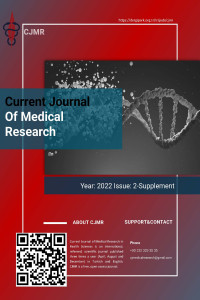Youtube; Kronik Venöz Yetmezlikte Kompresyon Çorabı Kullanımında Hastalar İçin Bilgi Kaynağı Olarak Kullanılabilir Mi?
Abstract
Amaç: Günümüzde teknolojinin hızla gelişmesiyle insanlar sağlık hakkında bilgi edinmek için interneti kullanmaya başlamıştır. YouTube da en popüler bilgi edinme sitelerinden biridir. Bizim bu çalışmamızdaki amacımız YouTube internet sitesi içerisindeki videoların kronik venöz yetmezlik hastalığında tedavi yöntemi olan kompresyon çoraplarının kullanımı açısından bilgi yeterliliğini değerlendirmektir.
Gereç ve Yöntemler: YouTube sitesinde 2018-2021 yılları arasındaki 296 adet video izlendi. “Varicose veins, compression stocking, varis çorabı tedavisi, venöz yetmezlik” anahtar kelimeleri kullanılarak arandı. İncelenen videolar; yayımlanma yılı, kimler tarafından yayımlandığı, süresi, izlenme sayısı, animasyon, hastalık-tanı-tedavi ile ilgili bilgi varlığı gibi kriterler kullanılarak faydalı, yarı faydalı ve faydalı olmayan üç gruba ayrıldı.
Bulgular: Toplamda bulunan 296 video en çok %40,5 oranıyla sağlık profesyonelleri tarafından yayımlanmıştır. Ancak izlenme sayılarına bakıldığında internet sitelerine ait videoların daha çok izlendiği belirlenmiştir (medyan 4.671). İzlenme sayısı ve yayımcı türleri arasında anlamlı bir fark yoktur (p:0,071). Videoların içeriklerinin faydalılıkları açısından bakıldığında özel hastane ve kliniklerin daha faydalı içerikler yayımladıkları bulundu (%61). Yayımcı türleri arasında anlamlı fark bulundu (p<0,001). Faydalı veya faydasız içerikli videoların izlenme sayıları arasında anlamlı bir fark olmadığı tespit edildi (p:0,489).
Sonuç: Çalışmamıza göre kompresyon çorabı ile ilgili videoların %34,5’inde faydalılık saptandı. En faydalı içeriklerin özel hastane-kliniklerde olmalarına rağmen en çok izlenme sayısı internet sitelerindeydi. Yayımlayıcıların, videolarını hastalık-tanı-tedavi bilgileri açısından geliştirmeleri videoları daha faydalı hale getirecektir. Özel hastane-kliniklerin ve sağlık profesyonellerinin; daha çok insana hitap edebilecek, animasyonlarla desteklenecek videolar paylaşmaları YouTube’un faydalı bilgi kaynağı olarak kullanılmasını sağlayacaktır.
Keywords
Youtube; Can It be Used as a Source of Information for Patients in Using Compression Stocking in Chronic Venous Sufficiency?
Abstract
Objective: Today, with the rapid development of technology, people have started to use the internet to learn about health. YouTube is one of the most popular information learning sites on the internet. Our aim in this study is to evaluate the information adequacy of the videos on the YouTube website in terms of the use of compression stockings, which is a treatment method in chronic venous insufficiency disease.
Material and Methods: Between the years 2018-2021, 296 videos were watched on YouTube. Varicose veins were searched using the keywords “compression stocking, compression stockings treatment, venous insufficiency”. The videos examined were divided into three groups; useful, semi-useful and non-useful, using criteria such as the year of publication, by whom they were published, the duration, the number of views, animation, the presence of information about the disease-diagnosis-treatment.
Results: A total of 296 videos were published by health professionals with a maximum rate of 40.5%. However, considering the number of views, it was determined that the videos of the websites were watched more (median 4.671). No significant difference between views and publisher types (p<0.001). It was found that there was no significant difference between the number of views of videos with useful or useless content (p:0,489)
Conclusion: According to our study, usefulness was found in 34.5% of the videos about compression stockings. Although the most useful content was in the private hospitals-clinics, the highest number of views was on the internet sites. It will be useful for publishers to improve their videos in terms of disease-diagnosis-treatment information. Sharing videos that will appeal to more people than private hospitals-clinics and health professionals and that will be supported by animations will enable YouTube to be used as a useful source of information.
Keywords
Details
| Primary Language | Turkish |
|---|---|
| Subjects | Clinical Sciences |
| Journal Section | Conference Paper |
| Authors | |
| Publication Date | December 6, 2022 |
| Submission Date | June 8, 2022 |
| Published in Issue | Year 2022 Volume: 2 Issue: 2-Supplement |


